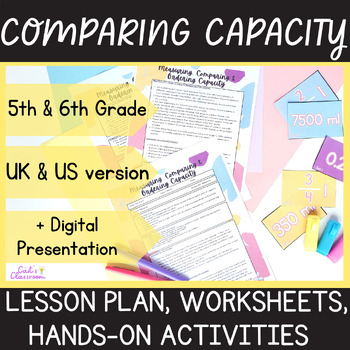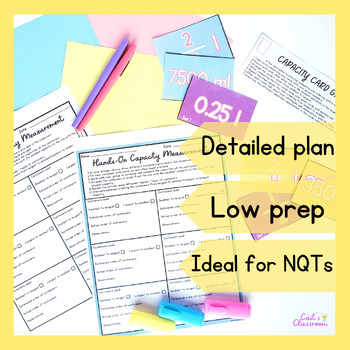Comparing Capacity│Lesson Plan,Hands-on Activities,Worksheets│5th/6th Grade Math
- Zip
Also included in
- 5th/6th grade end of year math fun! Looking for a complete unit on liquid volume and capacity measured in liters and milliliters? Want it to include step-by-step lesson plans, hands-on measurement activities, digital presentations/software, engaging games and practice worksheets? Then this resourcePrice $18.00Original Price $25.75Save $7.75
- 5th/6th grade end of year math fun! Preparing to teach metric weight and capacity? From liters and milliliters to tons and kilograms, this unit features hands-on measurement games/activities, digital/printable resources and detailed lesson plans.Designed specifically with newly qualified teachers inPrice $29.70Original Price $45.68Save $15.98
Description
Searching for a fun, engaging lesson for fifth/sixth grade on measuring, ordering and comparing liters and milliliters? Want it to include a warm-up game, hands-on measurement, a digital presentation and independent practice? Then this resource is for ✨️YOU!✨️
This resource includes UK and US spellings and is also aligned with both CCSSM and the Irish Primary Mathematics Curriculum (2023) for seamless integration into planning documents. ✏️.
Take the stress out of creating complete lesson plans and resources! Help your students excel in math while reclaiming your valuable downtime with this engaging, curriculum-aligned lesson plan. Grab your copy TODAY!
⭐️Benefits⭐️
✅️Reduces planning demands on teachers, saving valuable time and effort while being well-designed and aligned with curriculum standards.
✅️Offers a comprehensive resource with step-by-step instructions, ideal for newly qualified teachers who want support teaching math to the senior grades.
✅️Enhances conceptual understanding and procedural fluency in measuring, comparing and ordering liters and milliliters in fractional/decimal form.
⭐️In Depth Description⭐️
This 45-minute lesson plan includes:
✅ Capacity Card Game (4 sets of 6 cards) - Engages students in interactive gameplay, reinforcing understanding of comparing and ordering measurements in decimal/fractional form.
✅ 1 group worksheet (colour and black & white) - Fosters collaborative learning as students work together to practice measuring, comparing and ordering capacity, promoting peer interaction and discussion.
✅ 1 individual worksheet (colour and black & white) - Provides independent practice opportunities for students to demonstrate their understanding of comparing and ordering measurements.
✅️Math Talk digital presentation: Provides a clear focus for math discussions, encouraging student participation and collaboration.
✅️3 learning objectives: Clearly defines lesson outcomes, guiding both teachers and students in their learning goals.
✅️Differentiation strategies: Accommodates diverse learning needs, ensuring all students can access and succeed in the lesson.
✅️Assessment strategies: Provides practical guidance on assessing student understanding throughout the lesson.
✅️Key vocabulary and definitions: Equips students with essential language for effective communication about liquid volume and capacity concepts.
✅️Exit tickets (colour and black & white): Quickly gauges student understanding at the end of the lesson, providing valuable feedback for future instruction.
✅️ Fully aligned with the new Primary Mathematics Curriculum (2023),specifically the element of reasoning and the competencies of being mathematical and being an active learner.
✅️Common Core aligned - CCSS.5.MD.A.1, CCSS.MP5 , CCSS.MP6
⭐️Other Uses⭐️
- Math Centers: Use the Capacity Card Game as part of a math center rotation, allowing students to practice comparing and ordering measurements while enjoying interactive gameplay.
- Peer Teaching: Assign the group worksheet as a peer teaching activity, where students collaborate in small groups to complete tasks related to measuring, comparing, and ordering capacities. This encourages teamwork and peer interaction while reinforcing learning.
- Homework Extension: Assign the individual worksheet as homework or independent practice, providing students with opportunities to reinforce their understanding of comparing, and ordering liters and milliliters outside the classroom setting
➡️ Don't let this opportunity slip away! Elevate your teaching experience and engage your students - secure your complete lesson plan and resources TODAY! ⬅️
Click here to join the Cáit's Classroom mailing list for valuable tips, tricks, and special offers designed to support newly qualified teachers in effectively teaching maths to 3rd-6th grade students.
Related Products
⭐ Capacity & Liquid Volume│Math Lesson Plan Hands-on Activities Worksheets│5th/6th
⭐ Increasing Liquid Volume Lesson Plan│Excel/Sheets Activity│5th/6th Grade Math
⭐ Liquid Volume & Capacity │5-Day Unit│Lessons Worksheets Games Activities 5th/6th
⭐ Math Lesson Plan │Units of Capacity Hands-On Activities/Worksheets│5th/6th Grade
⭐ Converting Capacity│Lesson Plan,Hands-on Activities,Worksheets│5th/6th Grade Math







